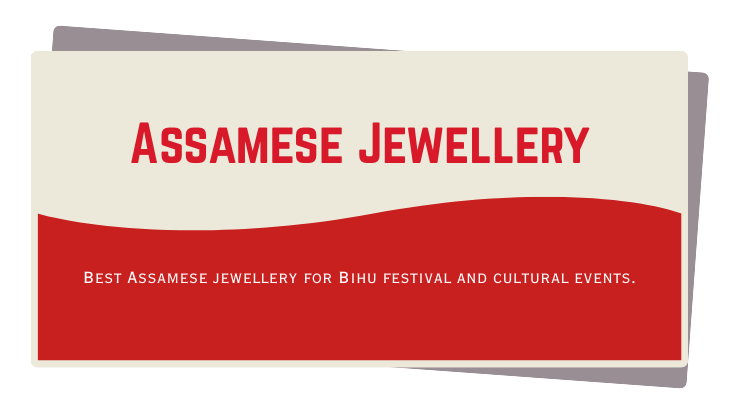Best Assamese jewellery for Bihu festival and cultural events.
Blog post description.
ASSAMESE TRADITIONAL JEWELLERY
Kasturi Gogoi
11/9/20253 min read


Bihu is more than just Assam’s most loved festival—it’s a celebration of culture, music, dance, and vibrant traditions. And one of the most beautiful expressions of that heritage is Assamese jewellery. During Bihu, women wear bright Muga silk Mekhela Chadors adorned with traditional ornaments that reflect Assamese pride and artistry. From the crescent-shaped Jonbiri and the powerful Gam Kharu bangles to the symbolic Loka Paro and festive Dholbiri necklaces, each piece tells a story of love, prosperity, and joy. These ornaments aren’t just accessories—they’re part of the rhythm, dance, and spirit of Bihu itself. Here’s a look at the best Assamese jewellery pieces to wear during Bihu festivals and cultural events, along with tips on how to style them for a perfect traditional look that still feels fresh and timeless.
Best Assamese Jewellery for Bihu Festival and Cultural Events
1. Jonbiri – The Icon of Elegance
One of the most recognizable pieces of Assamese jewellery, Jonbiri is a crescent-shaped pendant that symbolizes the moon.
Why it’s perfect for Bihu: It captures grace and charm, mirroring the joyful spirit of Bihu dance.
Style tip: Pair it with a red or golden Mekhela Chador and minimal earrings for a balanced look.
2. Gam Kharu – The Symbol of Strength
The bold, round Gam Kharu bangles represent power and prosperity. Traditionally made of gold or silver, they’re often worn in pairs.
Why it’s perfect for Bihu: Its bold design complements energetic dance movements and festive attire.
Style tip: Combine with soft curls or a braid, letting the bangles stand out as your statement accessory.
3. Loka Paro – Love and Harmony
This ornament features twin pigeon motifs that symbolize love and peace. Loka Paro can be worn as earrings or a necklace.
Why it’s perfect for Bihu: It represents togetherness and affection—values at the heart of the festival.
Style tip: Wear Loka Paro earrings with a golden saree or a traditional Mekhela for cultural performances.
4. Dholbiri – The Necklace of Joy
Inspired by the Assamese drum (dhol), Dholbiri features drum-shaped motifs and is a staple during festive dance events.
Why it’s perfect for Bihu: It symbolizes rhythm, music, and celebration.
Style tip: Pair it with vibrant reds or yellows to capture the color and energy of the festival.
5. Dugdugi – The Necklace of Romance
Often mistaken for Dholbiri, Dugdugi has heart-like designs that represent affection and beauty.
Why it’s perfect for Bihu: Its delicate yet bold look adds a touch of romance to festive outfits.
Style tip: Layer Dugdugi with a lighter gold chain or wear it solo for a classy, minimal appearance.
6. Thuria – The Classic Earrings
These sun-shaped earrings with enamel work are among the oldest Assamese designs.
Why it’s perfect for Bihu: Their bright, circular shape mirrors joy and radiance.
Style tip: Go for red or green mina (enamel) Thurias that pop against traditional silk or cotton sarees.
7. Keru Bala and Muthi Kharu – Everyday Elegance
Lighter gold bangles like Keru Bala or Muthi Kharu are ideal for long Bihu celebrations.
Why it’s perfect for Bihu: They’re comfortable for dancing and look graceful when layered.
Style tip: Mix one bold Gam Kharu with a few light bangles for a festive yet practical combo.
8. Bena – The Hair Ornament
A lesser-known but beautiful accessory, Bena decorates the hair bun or braid.
Why it’s perfect for Bihu: It completes the traditional dancer’s look with elegance.
Style tip: Pair it with jasmine flowers for a graceful Assamese touch.
FAQs
What Assamese jewellery is most commonly worn during Bihu?
Jonbiri, Gam Kharu, Dholbiri, and Thuria are the most traditional and popular choices.
Can I wear Assamese jewellery with fusion or modern outfits at cultural events?
Yes! Try pairing Jonbiri or Loka Paro earrings with Indo-Western sarees or flowy skirts.
Are Assamese ornaments heavy to wear while dancing?
Most traditional pieces are lightweight, but you can also find imitation versions made for performance comfort.
Where can I buy authentic Assamese jewellery?
From Assamese jewellers, local artisans, or online ethnic jewellery platforms that promote traditional crafts.
Conclusion
Bihu isn’t just a festival—it’s a feeling, and Assamese jewellery captures that emotion perfectly. From the moonlike beauty of Jonbiri to the rhythmic charm of Dholbiri, each piece celebrates Assamese identity and craftsmanship. Wearing these ornaments during Bihu and cultural events connects you to generations of artistry and pride, while keeping your festive look radiant, traditional, and unforgettable.